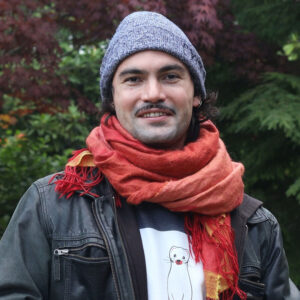
Time and elements in ecosystems
Pierre Rogy is a PhD student in Dr. Diane Srivastava's lab at the University of British Columbia. Pierre studies how temporal dynamics in an ecosystem, including the growth rate of organisms within a food web, are related to the flow of elements through that ecosystem. Pierre also looked at biocontrol of pest species in orange orchards in Costa Rica through the use of bromeliads as habitats for beneficial predatory insects in the orchard.
Video Transcript
I had this kind of fascination for tiny creatures that move around, and I guess especially because when you look at them with the naked eye you only see like the macro parts, but as soon as you get a microscope and look at them closer you realize how like crazy complicated and like beautiful they are.
Hi, my name is Pierre Rogy, I'm a doctoral student in the lab of Dr. Diane Srivastava, and I did my masters in this lab as well. So my lab studies bromeliads which are in the same family as pineapple. So you could picture a bromeliad by taking a pineapple and cutting the fruit and just keeping the leaves, and you have this kind of structure where you have leaves pointing upwards then outwards and there is space between these leaves. And in this space you have water that accumulates and in this water you have a mini ecosystem composed of larvae of mosquitoes, dragonflies, and other insects.
I did my master's field work in the city of Santa Cecilia in the north of Costa Rica and the idea was to see if bromeliads could be used in the context of biological control. And so that's the study that we did where we looked at the impacts of bromeliads on insects on orange trees in orange plantations.
Now I'm doing my PhD on something that's more theoretical. The idea would be to bridge two different theories in ecology. The first one is that of Energy Channels. So if you picture a forest ecosystem say and in that forest you have deer and rabbits, they both are herbivores but they do not feed on the same plants because for example the deer are going to feed more on small trees while the rabbits are going to feed more on smaller plants like grasses. So they're both herbivores but they feed on different plants and so they form what we call energy channels that would be connected on top by a predator like a wolf.
As you imagine deer and rabbits have different temporal dynamics, so it's easier to get a lot more rabbits than to get a lot more deer. Just because deer take longer to reproduce and so that means that we've got different temporal dynamics that are connected by a single predator or a single group of predators. So that's really interesting to investigate. Energy channels allows you to bring inside the same framework, different channels which have very different temporal dynamics and so I'm trying to bridge that with Ecological Stoichiometry which is the study of the relative quantity of elements within organisms and communities and ecosystems.
The join between the two theories is made on the temporal dynamics because there's a theory that's called a Growth Rate Hypothesis hypothesis and it basically states that organism organisms that have faster growth rates contain a higher proportion of phosphorus, and it's simply because when you produce new cells you need a lot of phosphorus. That's where the link is and so in my thesis I'm trying to use Ecological Stoichiometry and this Growth Rate Hypothesis within the context of Energy Channels because, if you recall earlier, I said that some channels have faster temporal dynamics than others, so like the rabbits reproduce faster than the deer. So if we translate this in terms of stoichiometry it would mean that rabbits have higher phosphorus content than deer. This link hasn't been made yet and that's what I'm trying to do in my thesis.